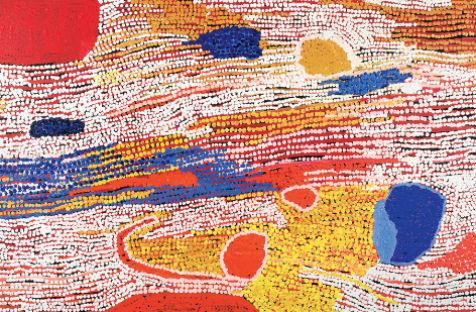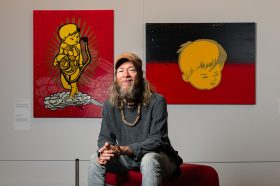Frontiers can be found in any discipline, and boundaries constantly shift under the influence of unlikely pioneers. In Australia, the frontier for Indigenous rights is being tested through ongoing legal challenges involving art and cultural heritage. The proverbial line in the sand, however, is not an imaginary one; it is being depicted on canvas, on bark, on rock, and in the actual desert sand.
Art and cultural heritage debates have played an important role in influencing changes to Australian jurisprudence affecting Indigenous rights, in particular intellectual property law. Art is now challenging assumptions and strictures in the legal domains of land rights and cultural criminology, where the basis and implications of art as a statement of law is being explored, and art has recently been the subject of a novel human rights test case for the Aboriginal peoples of the Kimberley region of Western Australia.
There is a growing body of case law in Australian and other post-colonial settler states, which documents the status and significance of art alongside other cultural practices as evidence of cultural tradition and connection to country.
The Yolngu people of Australia’s Northern Territory were early proponents of making the land/law nexus of their culture more public, and have made several petitions and legal claims using art as evidence of customary law, particularly as it relates to historical accounts of traditional exercise of rights and concepts of ownership. In 1962 elders installed bark paintings depicting secret sacred designs, never before seen in public, in the mission church in their community Yirrkala. The following year, clan elders created the now famous Yirrkala Bark Petition, in protest against mining in their country… A case was heard in 1968, which found against the Yolngu, but ensuing broad spectrum public support contributed to the passing of Aboriginal Land Rights (Northern Territory) Act 1976
…
Aboriginal artists have always employed art in various forms to document connection to country—in effect, title—but with respect to Native Title claims, coordinated efforts by certain peoples have been hindered by their enforced dislocation from country.
In 1996, the Spinifex Arts Project was established to record and document ownership of the Spinifex area (a large tract of country covering the Great Victoria Desert in south Western Australia) in support of the Spinifex Peoples’ Native Title claim over 55,000 square kilometres of land, lodged the year prior. In 1997, the Project produced the Men’s and Women’s Native Title Claim Paintings, which were developed around places of birth, linking concepts of traditional ownership with knowledge and responsibility for country. They mapped the Tjukurpa tracks within the Spinifex claim area, demonstrating the complexity of the claimants’ intimacy with country, including religious beliefs and practices. Mark Anderson, who is represented in the Corrigan collection with a work detailing specific water sites, acted on behalf of the Pila Nguru People (also known as the Spinifex People) in the Native Title determination before the Federal Court. The successful Native Title agreement was ratified in November 2000 and, as testament to their significance as evidentiary statements of title to the Spinifex Lands, the claim paintings were formally included in the legal preamble.
Mabo and the Native Title Act have variously been interpreted by several authors as extending legal protection over other forms of traditional Aboriginal interests, and that art, in particular, deserves special attention, as it represents “a nature or incident” of Native Title and is subject to the “same restrictions as land regarding alienability”.
The Ngurrara (my country) artists and claimants of the Mangkaja community in the Fitzroy Crossing region of north Western Australia painted a massive map of country in 1997 as part of their Native Title claim, which illustrated links to 80,000 square kilometres of land. Ten years later this work was a physical part of the Native Title determination proceedings, which were held in country on 8 November 2007. The Federal Court also found in their favour, and in several of the images accompanying the National Museum of Australia’s website on the Ngurrara canvas, you can see the claimants literally standing their ground, on their country, the painting.
Two key elements at work in Aboriginal contemporary art, the power of Aboriginal law, or Tjukurpa[i] , and the mesmerising array of colour used to depict country and culture, are showcased in Power + Colour: New Painting from the Corrigan Collection of 21st Century Aboriginal Art. These contemporary works offer an aesthetic that fuses visual dynamism with a powerful connection to the primal through living links to a complex spiritual practice that is intricately and intimately tied to law and land. The selection of one hundred and twenty-nine works of art in Power + Colour is new painting that radiates power: the interconnected power of law and country.
[i] Tjukurpa is defined as the foundation of Aboriginal peoples’ belief systems and society and is the most commonly used Aboriginal term translated into English as ‘dreaming’ and the ‘dreamtime’. In English, however, there is no single word that conveys the complex meaning of Tjukurpa, which encompasses religion, law and moral systems that are interwoven in the past, present and future.
This article is an extract from the introductory essay to Power+Colour: New Painting from the Corrigan Collection of 21st Century Aboriginal Art which charts the history of Aboriginal art’s impact on Australian law, and explores the inextricable nexus of Aboriginal law and sense of self.





